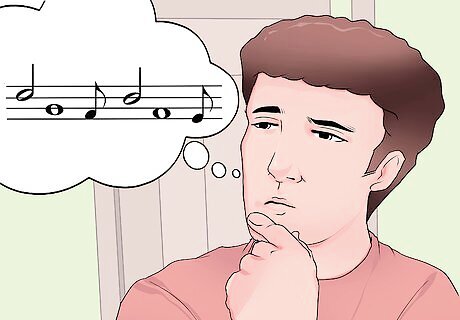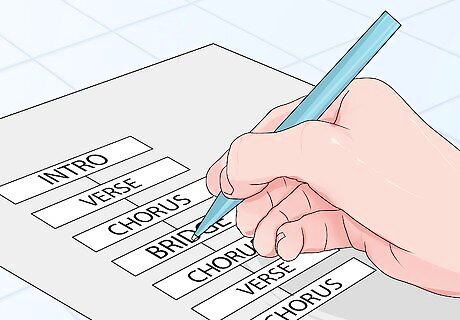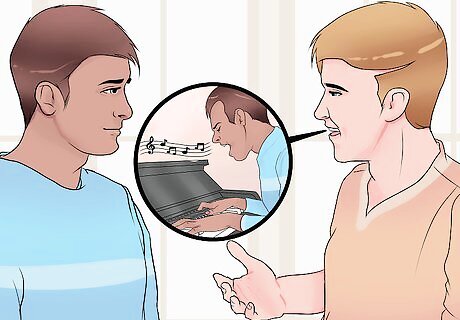
views
Getting Inspired

Decide what type of song you want to write. Do you want to write a pop song, a country song or even a classical song? Take some time to listen to a few examples of whichever you choose to get a feel for them. Take note of the rhythms, structure, and harmonic progression of other songs of the type you choose. Your notes will help you stay on the right track. Choose the type of song you’d like to listen to. It will keep you motivated.

Decide what you want your song to be about. Take a few minutes to meditate about the things that are important to you. You may want to write a love song for your sweetie or a song about a historical event. Make sure your topic is something you personally connect with. Give your song an emotional core.

Find your tone. How do you want your audience to feel when they listen to your song? Your tone will affect the way you write the song. A song about a new love would likely be upbeat and happy and likely in a major key. A song about the death of a loved one would likely be slow and somber and use a minor key. Elton John’s emotional tribute to Marilyn Monroe, “Candle in the Wind,” is a perfect example of a song with a powerful somber tone. Over 20 years after he wrote the song, John played it beautifully at the funeral of Princess Diana. Bruno Mars’ “Amazing,” about the joy of being in love, is a perfect example of a song with an effective upbeat and happy tone. Think about your feelings toward the subject of your song and choose a mood that will communicate it to the audience.

Choose a title. Always keep your eyes and ears open for possible titles. You never know where you might find a great one. Skim newspapers. Read books. Have conversations. The perfect title could reveal itself to you in the unlikeliest of places. Another great way to find a title is to make a metaphor for your topic. If your title comes from a conversation with someone else, be sure to ask that person permission before you use it.

Discover your melody. Play around on your piano for a while and try to find a tune that fits your mood. Try to feel the emotion you wish to invoke while you play. If it’s a happy song, let your fingers be light and bouncy. If it’s a sad song, slow everything down and take time to let the notes resonate. You can even hum your melody first and then try to find the corresponding keys on the piano. Keep it simple and catchy for now. You’ll build on it later.
Planning your Song

Get blank music staff paper. You can download blank staff paper off the Internet or buy it at almost any music store. If you prefer, you can even create your own. Make 2 rows of 5 straight lines, one on top of the other with some space in between. Then split each row into 4 columns to make the measures. Be sure to use a ruler to get clear, straight lines. If you don’t want to write your song on paper, you can always use a music notation software like MuseScore.

Decide on a time signature. A time signature notifies you how a song will be counted. You’ll see it written like a fraction at the beginning of any piece of music. If your song has a quick pace, you might use 2/2 or "cut" time. The most frequently used time signature is 4/4, also called "common" time. The top number means that you’ll have 4 beats in a measure. The bottom number means that you’ll count each beat as a quarter note. In common time, there a few different types of notes that have varying values. A half note has the value of 2 quarter notes or 2 beats. A whole note has the value of 4 quarter notes or 4 beats. An eighth note has the value of 1/2 of a quarter note. A dot immediately following a note increases that note by half its value. A half note would then last for 3 beats.

Discover your key. The key is basically the arrangements of sharps and flats in your song. If you have no sharps or flats in your scale, you will be in the key of C major. For every fifth you move up from C, you add a sharp (black key above a note) to your scale. If you move from the key of C to the key of G, you would add an F sharp. For every fifth you move down from C, you add a flat to your scale. So if you dropped from the key of C to the key of F, you would add a B flat. This system is called the circle of fifths. The order in which sharps are added is F, C, G, D, A, E, B. The order in which flats are added is reversed, B, E, A, D, G, C, F. Minor keys have a darker tone and follow the same rules. The key of A minor has no sharps or flats and you can move up or down from there. Every key has a different mood or "color" so experiment a bit until you find one that feels right for your song.

Find out your chord progression. A good chord progression for your song will give it a coherent structure. There are few different chord progressions you can follow. One of the most popular is the Nashville progression. To use the Nashville progression, you’ll have to find your root chord, (the same as your key) your dominant chord, (the fifth chord above your root) your sub-dominant chord (the fourth chord above your root) and the six chord (this will be a minor chord). This may sound confusing but it’s actually pretty easy. If you’re in the key of C, you would count a fifth step from C to find your dominant chord. You would say “C, D, E, F, G.” G would be your dominant chord. In the key of C, C is your root chord, G is your dominant chord, F is your sub-dominant chord, and A minor is your six chord.

Create a chorus. Your chorus will be the most recognizable part of your song. It’s the part of your song that will hook your audience in. You’ll repeat it, exactly the same way, over and over throughout your song. You want it to be as catchy as possible. You can set your chorus apart from the rest of your song by making it louder. Make it emotionally moving by creating a memorable chord progression. Your audience will likely connect with your chorus more than any other part of your song.

Create verses. Verses tell the story of the song. If your song has lyrics, your verses should relate to the chorus. Your song should have several verses and each one should come before a chorus. All your verses should have a similar tune or chord progression, though there can be slight variations in rhythm, instrumentation, or vocals. You can make each verse its own story or you can continue a story through all your verses. Your last verse should be the payoff. It should reward the audience for listening to the song and end the story. For example, if your song is about falling in love, the last verse may be about when the lovers finally kiss.

Create a bridge. Your bridge will only appear in your song once. It serves to break up the song and its tune should be very different, musically, than that of the rest of your song. A good place to put your bridge is after 2 cycles of your verse and chorus. Introduce a new tune or rhythm in your bridge. Try to surprise your audience with a unique bridge they never expected.
Putting it Together

Transpose your song. Write down your melody on your staff paper. Remember that most of the tune of the song should be written in the treble clef (the top clef to the right of middle C on the piano) and played with your right hand. The notes in your bass clef (the bottom clef to the left of middle C on the piano) should be played with your left hand and used mostly to keep rhythm. Chords in your bass clef can be a great way to keep rhythm. The notes on the lines in the treble clef from bottom to top are E, G, B, D, F. They can be remembered by the mnemonic device “Every good boy does fine.” The notes on the spaces of the treble clef are F, A, C, E. You can remember they spell "face." The notes on the lines in the bass clef are G, B, D, F, A. You can remember them with the mnemonic device “Great big dogs fight animals.” The notes on spaces of the bass clef are A, C, E, G. You can remember them with the mnemonic device “All cows eat grass.”

Structure your song. When you’ve written all the parts of your song, arrange them in the best possible order. Decide how many times you want to repeat your melody and chorus. Choose the best place to play your bridge. Find the best flow for your song. You can always change this later on. What sounds like the best arrangement today may not sound as good the next day. After you write the song, leave it alone for a few days or weeks. Then, perform it for your family and friends and make any necessary changes before finalizing it.

Make an intro. Write an attention-grabbing intro to begin your song. Make sure it fits in with your key and time signature. Keep the intro short and sweet, you want to move into the meat of your song as quickly as possible. Sometimes intros can be longer. The keyboard solo at the beginning of “Baba O’Riley” by The Who is an example of a long intro being used very effectively to build suspense.

Play around. Play your song as many different ways as you can. Experiment with making parts of it louder and softer. You may even change parts of the song entirely the more you play it. Be creative and let yourself explore new possibilities. Keep track of what you revise just in case you change your mind later.

Write lyrics. After you’ve played your song a few times, decide whether or not you want to add lyrics. If you’re writing a complex, classical song, it may not need lyrics. Most pop songs however, do have lyrics. If you do decide your song needs lyrics, try to write words that are catchy and that fit into the mood of your song. The most important thing is to use lyrics that resonate with you and your audience. One way to write catchy lyrics is by making them rhyme. In “Imagine” John Lennon says “Imagine there’s no heaven. It’s easy if you try. No hell below us. Above us only sky.”
Performing your Song

Practice your song. Play your song over and over until you can play it comfortably without much thought. Practice your song slowly until you can play it perfectly so that your mind has time to absorb everything and your fingers build the correct muscle memory. Break the song down. Try to learn only a few measures at a time. When you have those down perfectly, move on to the next few measures. You can also go a measure at a time from the end of the piece. If you play the last measure perfectly, play the last 2 measures until you get them perfect, and so on. When you start to lose concentration, take a break. You’ll be wasting your time trying to play the piano if your brain is too tired to focus.

Find your audience. You’ll need someone to perform for. The first few times you perform you’ll want a supportive audience as everything might not go as planned. Your friends and family are unlikely to be too critical if you make a few mistakes the first few times you perform your song for them. As you gain experience, you may want to visit open mics or find other places musicians can perform. Start with smaller venues and perform your song there before moving onto bigger venues and audiences.

Perform your song. Share your hard work with the world. If you start to feel a little bit of performance anxiety, take deep breaths until you feel yourself relaxing. Better yet, you can channel all our nervous energy into your performance. Try to feel all the emotions you felt writing your song when performing it for an audience.

Listen to feedback. You don’t have to pander to everyone’s opinion but you should at least hear it. You may get great advice about how to make your song more interesting or tips on how to put on a more exciting performance. Take criticism with a grain of salt. Sometimes people will be jealous of your skill and say things just to be mean. Run everyone’s advice through your own filter. Sometimes well-meaning people may give bad advice.




















Comments
0 comment